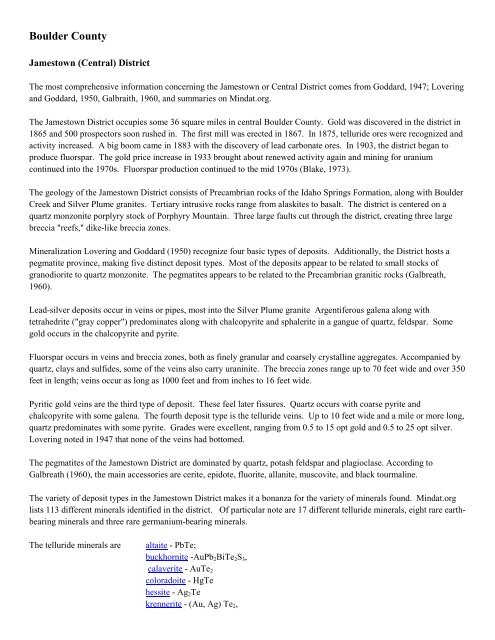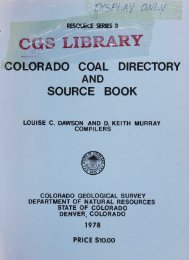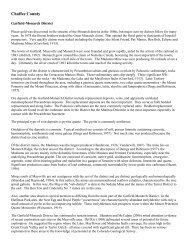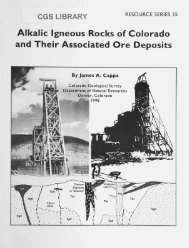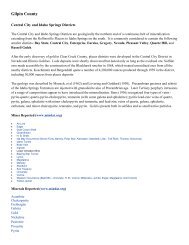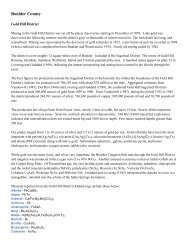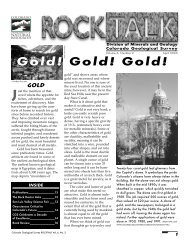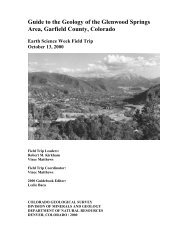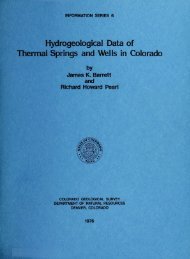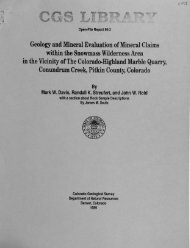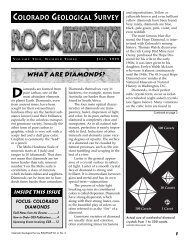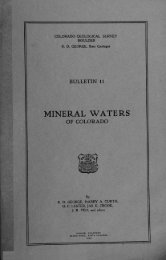Jamestown District.pdf - Colorado Geological Survey
Jamestown District.pdf - Colorado Geological Survey
Jamestown District.pdf - Colorado Geological Survey
Create successful ePaper yourself
Turn your PDF publications into a flip-book with our unique Google optimized e-Paper software.
Boulder County<br />
<strong>Jamestown</strong> (Central) <strong>District</strong><br />
The most comprehensive information concerning the <strong>Jamestown</strong> or Central <strong>District</strong> comes from Goddard, 1947; Lovering<br />
and Goddard, 1950, Galbraith, 1960, and summaries on Mindat.org.<br />
The <strong>Jamestown</strong> <strong>District</strong> occupies some 36 square miles in central Boulder County. Gold was discovered in the district in<br />
1865 and 500 prospectors soon rushed in. The first mill was erected in 1867. In 1875, telluride ores were recognized and<br />
activity increased. A big boom came in 1883 with the discovery of lead carbonate ores. In 1903, the district began to<br />
produce fluorspar. The gold price increase in 1933 brought about renewed activity again and mining for uranium<br />
continued into the 1970s. Fluorspar production continued to the mid 1970s (Blake, 1973).<br />
The geology of the <strong>Jamestown</strong> <strong>District</strong> consists of Precambrian rocks of the Idaho Springs Formation, along with Boulder<br />
Creek and Silver Plume granites. Tertiary intrusive rocks range from alaskites to basalt. The district is centered on a<br />
quartz monzonite porplyry stock of Porphyry Mountain. Three large faults cut through the district, creating three large<br />
breccia "reefs," dike-like breccia zones.<br />
Mineralization Lovering and Goddard (1950) recognize four basic types of deposits. Additionally, the <strong>District</strong> hosts a<br />
pegmatite province, making five distinct deposit types. Most of the deposits appear to be related to small stocks of<br />
granodiorite to quartz monzonite. The pegmatites appears to be related to the Precambrian granitic rocks (Galbreath,<br />
1960).<br />
Lead-silver deposits occur in veins or pipes, most into the Silver Plume granite Argentiferous galena along with<br />
tetrahedrite ("gray copper") predominates along with chalcopyrite and sphalerite in a gangue of quartz, feldspar. Some<br />
gold occurs in the chalcopyrite and pyrite.<br />
Fluorspar occurs in veins and breccia zones, both as finely granular and coarsely crystalline aggregates. Accompanied by<br />
quartz, clays and sulfides, some of the veins also carry uraninite. The breccia zones range up to 70 feet wide and over 350<br />
feet in length; veins occur as long as 1000 feet and from inches to 16 feet wide.<br />
Pyritic gold veins are the third type of deposit. These feel later fissures. Quartz occurs with coarse pyrite and<br />
chalcopyrite with some galena. The fourth deposit type is the telluride veins. Up to 10 feet wide and a mile or more long,<br />
quartz predominates with some pyrite. Grades were excellent, ranging from 0.5 to 15 opt gold and 0.5 to 25 opt silver.<br />
Lovering noted in 1947 that none of the veins had bottomed.<br />
The pegmatites of the <strong>Jamestown</strong> <strong>District</strong> are dominated by quartz, potash feldspar and plagioclase. According to<br />
Galbreath (1960), the main accessories are cerite, epidote, fluorite, allanite, muscovite, and black tourmaline.<br />
The variety of deposit types in the <strong>Jamestown</strong> <strong>District</strong> makes it a bonanza for the variety of minerals found. Mindat.org<br />
lists 113 different minerals identified in the district. Of particular note are 17 different telluride minerals, eight rare earthbearing<br />
minerals and three rare germanium-bearing minerals.<br />
The telluride minerals are altaite - PbTe;<br />
buckhornite -AuPb2BiTe2S3,<br />
calaverite - AuTe2<br />
coloradoite - HgTe<br />
hessite - Ag2Te<br />
krennerite - (Au, Ag) Te2,
melonite -Ni Te2,<br />
nagyagite - Pb5Au(TeSb)4,<br />
paratellurite - TeO2,<br />
petzite - Ag3SbS3,<br />
rickardite - Cu7Te5,<br />
stutzite - Ag7Te4,<br />
sylvanite - (Ag, Au)2Te4,<br />
tellurantimony - Sb2Te3,<br />
tellurite - TeO2,<br />
native tellurium - Te<br />
tetradymite - Bi2Te2S<br />
Rare earth minerals are the following: (REE in the formula indicates one or more of the rare earth elements)<br />
allanite - (Ca,REE)2(Al,Fe 2+ , Fe 3+ )3(SiO4)3(OH)3<br />
bastnaesite - (REE)(CO3)F<br />
britholite - (Ree,Ca)5(SiO4,PO4)(OH,F)<br />
cerite - (Ce,Ca)10(SiO4)(OH,F)5<br />
yttrofluorite - (Ca,Y)F2<br />
gadolinite - (REE)2(Fe 2+ Be2Si2O10<br />
monazite - (REE,Th)PO4<br />
tornebohmite - (REE)2Al(SiO4)2(OH)<br />
The Germanium-bearing minerals are<br />
briartite - Cu2(Fe,Zn)GeS4<br />
germanite - Cu3(Ge,Fe)(S,As)4<br />
renierite - (Cu, Zn)11(Ge,As)2Fe4S16<br />
Mindat.org identifies over a hundred different mines/claims/prospects within the <strong>Jamestown</strong> <strong>District</strong>. The mines on the<br />
map of Goddard (1947) include the Fourth of July, Orofino, Pine Shade, Mayflower, Hercules, P)rincess, Longfellow,<br />
Copper Blush, December, Golden Age, Eureka, Sentinel, Grand Central, Earl, Grand Union, Lily, Standard, Gladiator,<br />
Rip Van Dam, Ellen, Durias, Vanadium, Black Diamond, Nugget, Little Don, Tippecanoe, Governor Group, Roman<br />
Eagle, Thunderbolt, Grouse, Greenback, Bondholder, New Brunswick,Kicking Horse, Last Chance, John Jay, Golden<br />
Bell, Ten-Forty, Buena, Yellow Girl, Invincible, Brown Spar, Chancellor, Nations Treasure, Emmett, Buckhorn,<br />
Burlington, Alice, Crackerjack, Bessie B., Golden Cross, Red Spruce, Goldfince, McKinley, Stanley<br />
Gladstone, Argo, Mt Pleasant, Consolation, Overland, and Atlantic.<br />
References:<br />
Mineral Resource Data System (MRDS) - Online Spatial Data – <strong>Jamestown</strong> <strong>District</strong><br />
Blake, Norman R., 1973, A Summary of Mineral Industry Activities in <strong>Colorado</strong> 1971; <strong>Colorado</strong> Bureau of Mines, Denver CO.<br />
Goddard, E.N. (1947), The Front Range Mineral Belt, in Vanderwilt, John W. Mineral Resources of <strong>Colorado</strong>, State of<br />
<strong>Colorado</strong> Mineral Resources Board, Denver CO.<br />
Goddard, E. N., 1946, Fluorspar Deposits of the <strong>Jamestown</strong> <strong>District</strong>, Boulder County, <strong>Colorado</strong>: <strong>Colorado</strong> Scientific<br />
Society Proceedings, v. 15, no.1, 47 p.<br />
Lovering, T.S. and Goddard, E.N., 1950, Geology and Ore Deposits of the Front Range, <strong>Colorado</strong>; U.S.G.S. Professional Paper 223.
Mindat.org; <strong>Jamestown</strong> <strong>District</strong> CO; accessed 19 July 2012.


